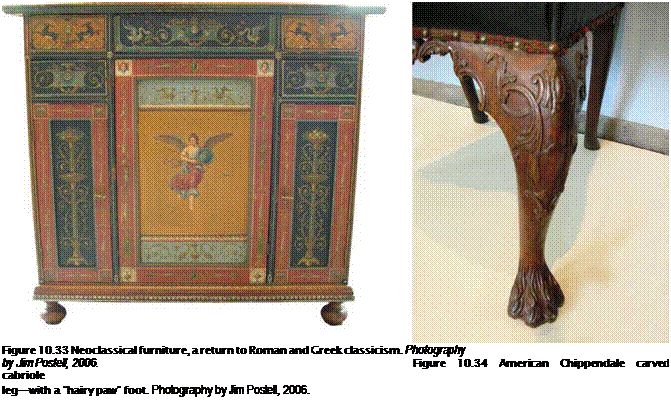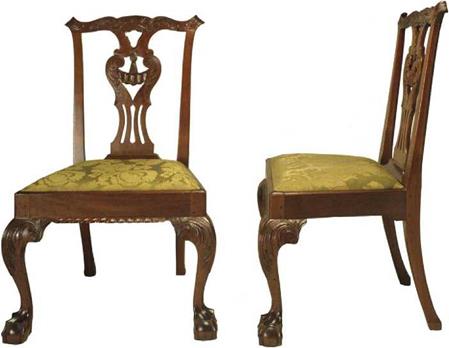
 The greatest influence on furniture design in the seventeenth century resulted from the growth of trade within the British Empire. Finally, it had become economically possible to transport finished pieces of furniture as well as raw material by ship. A significant new source of furniture and raw material was India, and trade with India and its adjacent lands became known as the Triangle Trade. As a result of the Triangle Trade, an excellent tropical hardwood. West Indian mahogany, was obtained. The abundant supply of this hardwood, and its demand by the furniture trades, allowed solid wood furniture to replace traditional veneer pieces, which had previously been the norm.
The greatest influence on furniture design in the seventeenth century resulted from the growth of trade within the British Empire. Finally, it had become economically possible to transport finished pieces of furniture as well as raw material by ship. A significant new source of furniture and raw material was India, and trade with India and its adjacent lands became known as the Triangle Trade. As a result of the Triangle Trade, an excellent tropical hardwood. West Indian mahogany, was obtained. The abundant supply of this hardwood, and its demand by the furniture trades, allowed solid wood furniture to replace traditional veneer pieces, which had previously been the norm.
Workers skilled in the techniques of japanning and oriental lacquer supplied Europe with new types of exotic finishes. Toward the end of the seventeenth century, imports from the Far East ignited a desire for painted and lacquered furniture (Figure 10.32). Solid wood furniture became popular because it withstood the voyage and climate better than veneered pieces, which buckled and split due to the climatic conditions during the sea voyages.
For a period of time in the eighteenth century, furniture was not signed; thus, relatively little is known about the fabricators. During this period, cabinet shops were small, often consisting of one master, one apprentice, and two journeymen. Outside of France, there were no strict guild systems; consequently, furniture could be fabricated in a number of ways by many individual craftsmen. In addition, setting up a cabinet shop was not an expensive endeavor. The cost compared favorably to that of importing furniture from across the ocean.
William Kent (1685-1748) was a British architect, interior designer, and furniture designer whose work emulated Palladian classicism and was admired by Ford Burlington. Fie was renowned for the furniture he made for Lord Burlington and his friends, as well as for his interiors and his picturesque landscapes. By the middle of the eighteenth century, the Rococo style had reached its zenith. When the Classical

Revival style became popular, critics began to speak out against extraneous curvilinear forms and demanded a return to less complex geometry. Attention returned to Roman classicism in particular (Figure 10.33).
Archeological publications flourished during this period. Robert Adam’s The Palace of the Emperor Diocletian at Spalato in Dalmatia (1764) enabled wealthy patrons to derive inspiration for grandiose schemes. In 1753, William Hogarth stated in his Analysis of Beauty, "the S-shape suggests motion and the pleasure of wandering gives pleasure entitling the word beauty."6 His view of beauty reinforced the spirit of the time and established a foundation for the emerging furniture designs of Thomas Chippendale and George Hepplewhite (a follower of the Neoclassical Adam style).
Thomas Chippendale (1718-1779) was an English designer and cabinetmaker who incorporated a variety of patterns and styles in his work. Early Chippendale pieces had cabriole legs (Figure 10.34) with details including Chinese bamboo and open fretwork. In 1754, he wrote and published, The Gentleman and Cabinet-Maker’s Director, an up-to-date manual for urban colonial and English cabinetmakers. It was immensely successful and was reissued in 1762. Chippendale’s drawings combined Chinese, medieval, and Rococo styles. His work, and particularly his chair designs, influenced a generation of cabinetmakers in North America (Figure 10.35). Chippendale’s furniture emphasized carving rather than inlay. Carved details were applied rather than hewn from solid lumber. Therefore, Chippendale was able to maintain an inventory of applied designs, large and small, to satisfy every client. Mahogany was the favored wood because it was easy to work and carve, was stable, and had a beautiful, consistent grain. After Sir Robert Walpole repealed the import duty on mahogany in 1733, it became affordable and plentiful for making furniture.
|
Figure 10.35 Pair of American side chairs, 1800. Courtesy of the Cincinnati Art Museum. Centennial Gift of Gloria Giannestras. In memory of Dr. Nicholas James Giannestras. Accession Number 1981.1. |




